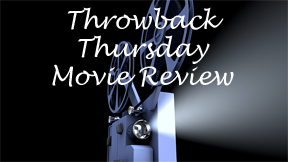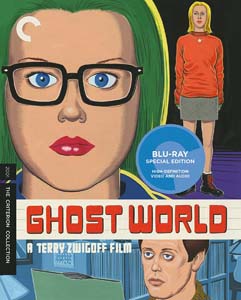It’s the mark of great cinema that a movie can mean one thing to a 20-something and another thing to a 40-something, but remain profound. Such is the case with “Ghost World” (2001), an adaptation of Daniel Clowes’ 1990s comic series that’s a touchstone of the era when – as Chuck Klosterman described in “The Nineties” — it was cool to not care.
When I watched writer-director Terry Zwigoff’s “Ghost World” in 2001 at roughly the age of Enid (Thora Birch), I saw it as the story of a high school graduate who struggles to fit in but pretends to not be bothered. Never quite finding her niche — despite coming close via her dalliances with Indian dance numbers, cruel pranks, rubber sex-fetish masks and blues music — she gives up and rides the bus out of her hometown. Maybe it’s a Bus to Nowhere, as that bus line is supposed to be out of service.
In this reading, the film is a tragic story of a good-hearted (although directionless and mistaken-prone) girl who is rejected by the world. Her best friend, Rebecca (Scarlett Johansson), is interested in getting an apartment and a job. Her loving milquetoast dad (Bob Balaban) reunites with an annoying ex. With art teacher Roberta (Illeana Douglas) championing her, Enid almost gets an art scholarship, but society’s censorious reaction to her work quashes that. Best to just give up and split town.

“Ghost World” (2001)
Director: Terry Zwigoff
Writers: Daniel Clowes, Terry Zwigoff; based on Clowes’ comic book
Stars: Steve Buscemi, Thora Birch, Scarlett Johansson
From the other side of the veil
But “Ghost World” is an inkblot test of a movie, with no wrong answer. As I view it today, at about the age of Seymour (Steve Buscemi), I see that Enid is unable (or unwilling, depending on how much blame you want to dole out) to grow up.
So the film is a tragedy of Enid rejecting the world. Prematurely curmudgeonly Seymour switches from being a heroic “so uncool he’s cool” role model to a cautionary tale, and his amusing rants reclaim the bluntness the character intended.
Although seemingly content with his record-collecting hobby, Seymour explains to his quirky young matchmaker friend Enid: “Maybe I don’t want to meet someone who shares my interests. I hate my interests.” It’s a funny line (like so many in the film), but it’s also pointed and poignant.
As Seymour extrapolates further: “You think it’s healthy to obsessively collect things? You can’t connect with other people, so you fill your life with stuff. I’m just like all the rest of these pathetic collector losers.”
Enid and Rebecca: Conflicting types of maturity
Zwigoff’s film is part of the coming-of-age genre, specifically the “last summer after high school” subgenre popularized by “American Graffiti.” But it never feels of a type, or even of a time. Yes, it’s quite Nineties with Enid’s disaffectedness. And other performances – like nunchuck-twirling convenience store shopper Doug (Dave Sheridan) – presage “Napoleon Dynamite” (2004) and the dry post-postmodernism of the Aughts.

But because Enid is searching for her time and place, time and place don’t matter – as symbolized by the Fifties diner that plays modern hip-hop and the fact that the film’s city is never named.
Because of the cinematic link to “American Graffiti,” Rebecca’s should-be threshold-smashing shift in behavior feels gradual and natural. Rebecca is right there with Enid in the beginning, making fun of their classmates and going all-in on the prank they’re playing on Seymour – luring him to a diner to watch him be sad about his date never showing up. Rebecca is colder than Enid, who is quicker to be ashamed by their behavior.
Rebecca is not a more mature person than Enid. But she acts out the steps of maturity (getting a job and an apartment), willing a true maturation to follow. Enid has organically grown as a person: She recognizes the value of Seymour as a human being, whereas Rebecca sees him as a dork the whole time. Rebecca immaturely hates Seymour for stealing Enid away from her, even going so far as to try to sabotage their friendship.
Still, Rebecca’s proscribed steps toward maturity do illuminate Enid as the one who can’t grow up (in the traditional way, with outward evidence of a job and apartment). As such, “Ghost World” becomes the inner tragic story of Enid – who has psychological issues to work through — rather than an outer tragic story. It’s a story of Enid causing bad things happen to her, rather than bad things randomly happening to Enid.
Seymour story
Now that Enid is an active (though ineffectual) protagonist rather than a passive one, we see in the 40-something view of “Ghost World” (the Seymour POV) how she is a bad influence on Seymour. This contrasts with the 20-something’s view (the Enid POV) of Seymour being a role model for Enid.
Seymour is actually making mature compromises when he wears mainstream girlfriend Dana’s (Stacey Travis) gift of a new pair of jeans, and when he displays her antique-store sculpture next to his record collection. (Dana finds they go together because they’re both old.) He’s humoring Dana. Enid sees this as selling out, but Seymour is actually smartly building an adult relationship.
Then, when Enid – understandably needing someone to be nice to her for 5 minutes after a series of depressing incidents – goes too far and sleeps with Seymour and suggests she move in with him, she reawakens the dreamer that Seymour had quashed within himself. Suddenly, this “beautiful young girl” is interested in him beyond his status as “an amusingly cranky eccentric curiosity.”
Transported into fantasy-land (a poignant thing in the 20-something’s viewing, a sad thing in the 40-something’s), he then foolishly breaks up with Dana. As salt in the wound, he’s fired from his steady job because he had given the controversial Coon’s Chicken Inn artwork to Enid, who used it in her class project. In a nutshell, Enid has ruined Seymour’s life. In his last scene before the credits, he’s in counseling, working on returning to his contented routine, dropping dreams of Enid, and even Dana.
However, Zwigoff – like the audience, and like Enid – thinks Seymour is awesome (which he is, despite his flaws). Therefore he gets the most laugh-out-loud scene of the movie after the credits, when he beats the crap out of Doug the nunchuck guy. Even though it’s a Buscemi outtake, it’s a grace note for Seymour, as if a weight has been lifted.
Norman and the bus
Here’s the bizarre and ingenious thing about the ending of “Ghost World” when viewed through the 40-something lens, something that solidifies the film as a masterpiece: The fact that Enid takes the seemingly out-of-service bus out of town switches from a symbol of continued aimlessness (maybe even a slog toward death, if one wants to be really dark) to a symbol of hopeful escape.
When we switch from Enid’s POV to Seymour’s POV, the bus that shouldn’t exist has become a Bus to Somewhere. When “Ghost World” is viewed through Enid’s lens, we’ve used up all our hope and dreams and the ending feels at best bittersweet. She is leaving her problems, but she hasn’t fixed herself, so she’ll only encounter new problems.
When viewed through Seymour’s lens where he doesn’t let himself get hurt anymore (and when he does, he recovers more quickly than he used to), the ending is now weirdly hopeful. Why? I think it’s because Enid reignited something in him – and in the viewer who is using his lens.
Old Norman (Charles C. Stevenson Jr.) — always sitting at the bus stop, rejecting Enid’s tip that the bus doesn’t stop here anymore with “That’s what you think” – boards the bus. Despite being old, he never gives up on his hope for a new path, and it pays off. Enid sees that, and she likewise takes this new, hopeful path – in her case with her whole life in front of her. She hasn’t fixed herself yet, but that’s no big deal. She has more time, and she’s going to a new place.
One door closes, and another opens. One view of “Ghost World” ends, and another begins. But one thing stays the same: It still ranks among my favorite films.
Also of interest: What I thought of “Ghost World” in 2001.

